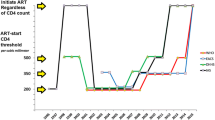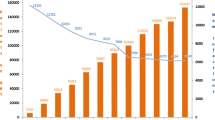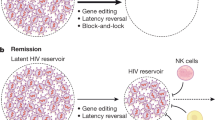Abstract
This article reviews the antiretroviral therapy (ART) initiation criteria from published national guidelines for 94 countries (representing 86 % of global HIV burden) and compares them with the 2013 World Health Organization (WHO) ART guidelines. As of 31st of July 2014, 19 countries have adopted the WHO-recommended CD4 eligibility criteria of ≤500 cells/mm3, while seven have opted to treat irrespective of CD4 cell count (“test and treat”). Together, these 26 countries represent 27 % of 2013 global HIV burden. Additionally, test and treat is recommended for selected groups of HIV-positive individuals, namely, (a) people with tuberculosis in 58 countries, (b) pregnant women in 42 countries, (c) people with liver disease due to hepatitis B co-infection in 52 countries, (d) serodiscordant couples in 35 countries and (e) children below 5 years in nine countries. Global access to treatment has improved; however in 2013, ART coverage was 12.9 million or 37 % of people living with HIV. Rapidly translating new science into policy is a critical component of the HIV response. Adapting and implementing the 2013 WHO treatment recommendations are necessary to prevent unnecessary illness, death, HIV transmission and costs.

Similar content being viewed by others
References
Papers of particular interest, published recently, have been highlighted as: •• Of major importance
UNAIDS. Gap report. Geneva, Switzerland 2014. Available from: http://www.unaids.org/en/media/unaids/contentassets/documents/unaidspublication/2014/UNAIDS_Gap_report_en.pdf (Accessed on: 17th July 2014).
UNAIDS. Getting to Zero 2011–2015 Strategy. Geneva, Switzerland 2010. Available from: http://www.unaids.org/en/media/unaids/contentassets/documents/unaidspublication/2010/jc2034_unaids_strategy_en.pdf (Accessed on: 9 July 2014).
Kitahata MM, Gange SJ, Abraham AG, et al. Effect of early versus deferred antiretroviral therapy for HIV on survival. N Engl J Med. 2009;360(18):1815–26.
Fang CT, Hsu HM, Twu SJ, et al. Decreased HIV transmission after a policy of providing free access to highly active antiretroviral therapy in Taiwan. J Infect Dis. 2004;190(5):879–85.
Das M, Chu PL, Santos GM, et al. Decreases in community viral load are accompanied by reductions in new HIV infections in San Francisco. PloS one.5(6):e11068.
Montaner JS, Lima VD, Harrigan PR, et al. Expansion of HAART coverage is associated with sustained decreases in HIV/AIDS morbidity, mortality and HIV transmission: the “HIV Treatment as Prevention” experience in a Canadian setting. PLoS One. 2014;9(2):e87872. Population-based ecological study that showed sustained population-level decrease in morbidity, mortality and HIV transmission as a result of HAART expansion between 1996 and 2012 in British Columbia, Canada.
Tanser F, Barnighausen T, Grapsa E, Zaidi J, Newell ML. High coverage of ART associated with decline in risk of HIV acquisition in rural KwaZulu-Natal. S Afr Sci. 2013;339(6122):966–71.
Cohen MS, Chen YQ, McCauley M, et al. Prevention of HIV-1 infection with early antiretroviral therapy. N Engl J Med. 2011;365(6):493–505. The first randomized clinical trial that demonstrated that immediate ART decreased sexual HIV transmission by 96.3 % among serodiscordant heterosexual couples.
Grinsztejn B, Hosseinipour MC, Ribaudo HJ, et al. Effects of early versus delayed initiation of antiretroviral treatment on clinical outcomes of HIV-1 infection: results from the phase 3 HPTN 052 randomised controlled trial. The Lancet infectious diseases. Mar 3 2014.
Granich RM, Gilks CF, Dye C, De Cock KM, Williams BG. Universal voluntary HIV testing with immediate antiretroviral therapy as a strategy for elimination of HIV transmission: a mathematical model. Lancet. 2009;373(9657):48–57.
WHO. Antiretroviral treatment as prevention (TASP) of HIV and TB. Geneva, Switzerland 2012. Available from: http://whqlibdoc.who.int/hq/2012/WHO_HIV_2012.12_eng.pdf (Accessed on: 9 July 2014).
WHO. Consolidated guidelines on the use of antiretroviral drugs for treating and preventing HIV infection. Geneva, Switzerland 2013. Available from: http://apps.who.int/iris/bitstream/10665/85321/1/9789241505727_eng.pdf (Accessed on: 9 July 2014).
WHO, UNICEF and UNAIDS. Global update on HIV treatment: results, impact and opportunities. Geneva, Switzerland 2013. Available from: http://apps.who.int/iris/bitstream/10665/85326/1/9789241505734_eng.pdf (Accessed on: 9 July 2014).
UNAIDS. Treatment 2015. Geneva, Switzerland 2013. Available from: http://www.unaids.org/en/media/unaids/contentassets/documents/unaidspublication/2013/JC2484_treatment-2015_en.pdf (Accessed on: 9 July 2014).
UNAIDS. Ambitious treatment targets: writing the final chapter of the AIDS epidemic. Geneva, Switzerland 2014. Available from: http://www.unaids.org/en/media/unaids/contentassets/documents/unaidspublication/2014/JC2670_UNAIDS_Treatment_Targets_en.pdf (Accessed on: 29 July 2014).
The World Bank. Data on country and lending groups. Available from: http://data.worldbank.org/about/country-and-lending-groups (Accessed: July 2014).
Nelson LJ, Beusenberg M, Habiyambere V, et al. Adoption of national recommendations related to use of antiretroviral therapy before and shortly following the launch of the 2013 WHO consolidated guidelines. AIDS. 2014;28 Suppl 2:S217–24.
Department of Health and Human Services. Guidelines for the use of antiretroviral agents in HIV-infected adults and adolescents 2000. Available from: http://aidsinfo.nih.gov/ContentFiles/AdultandAdolescentGL01282000010.pdf (Accessed on: 29 July 2014).
European guidelines for the clinical management and treatment of HIV-infected adults in Europe. AIDS. Jun 2003;17 Suppl 2:S3-26.
European AIDS Clinical Society. European guidelines for the clinical management and treatment of HIV infected adults. 2005. Available from: http://clinicaloptions.com/~/media/hiv/guidelines/euroguidelines-pocket guide.pdf.ashx (Accessed on: 30 July 2014).
WHO. Scaling Up Antiretroviral Therapy in Resource-limited Settings: Treatment guidelines for a public health approach. Geneva, Switzerland 2003. Available from: http://www.who.int/hiv/pub/prev_care/en/arvrevision2003en.pdf?ua=1 (Accessed on: 10 July 2014).
WHO. Antiretroviral therapy for HIV infection in adults and adolescents: recommendations for a public health approach. Geneva, Switzerland 2006. Available from: http://www.who.int/hiv/pub/guidelines/artadultguidelines.pdf (Accessed: 10 July 2014)
WHO. Antiretroviral therapy for HIV infection in adults and adolescents. Geneva, Switzerland 2010. Available from: http://whqlibdoc.who.int/publications/2010/9789241599764_eng.pdf (Accessed on: 10 July 2014).
Grant P et al. Association of baseline viral load, CD4 count, and week 4 virologic response (VR) with virologic failure (VF) in ACTG Study A5202. 18th Conference on Retroviruses and Opportunistic Infections, Boston, MA, USA, 2011. Abstract 535.
Strategies for Management of Antiretroviral Therapy Study G, Emery S, Neuhaus JA, et al. Major clinical outcomes in antiretroviral therapy (ART)-naive participants and in those not receiving ART at baseline in the SMART study. J Infect Dis. 2008;197(8):1133–44.
Early antiretroviral treatment and/or early isoniazid prophylaxis against tuberculosis in HIV-infected adults (ANRS 12136 TEMPRANO). Randomized control trial. Université Bordeaux, France. Available from: http://www.clinicaltrials.gov/ct2/show/NCT00495651 (Accessed: July 2014).
Hayes R, Ayles H, Beyers N, et al. HPTN 071 (PopART): rationale and design of a cluster-randomised trial of the population impact of an HIV combination prevention intervention including universal testing and treatment—a study protocol for a cluster randomised trial. Trials. 2014;15(1):57.
Iwuji CC, Orne-Gliemann J, Tanser F, et al. Evaluation of the impact of immediate versus WHO recommendations-guided antiretroviral therapy initiation on HIV incidence: the ANRS 12249 TasP (Treatment as Prevention) trial in Hlabisa sub-district, KwaZulu-Natal, South Africa: study protocol for a cluster randomised controlled trial. Trials. 2013;14:230.
START—strategic timing of antiretroviral treatment. Randomized trial. University of Minnesota - Clinical and Translational Science Institute, USA. Available from: http://clinicaltrials.gov/show/NCT00867048 (Accessed: July 2014).
Sustainable East Africa Research in Community Health (SEARCH). Randomized trial. University of California, San Francisco, USA. Available from: http://www.clinicaltrials.gov/ct2/show/NCT01864603 and http://hiv.ucsf.edu/research/international/search.html (Accessed: July 2014).
Rodger A et al. HIV transmission risk through condomless sex if HIV+ partner on suppressive ART: PARTNER study. 21st Conference on Retroviruses and Opportunistic Infections, Boston, abstract 153LB, 2014. Large observational study in 14 European countries that found no transmissions within heterosexual or gay couples from a partner with an undetectable viral load.
Marrazzo JM, del Rio C, Holtgrave DR, et al. HIV prevention in clinical care settings: 2014 recommendations of the International Antiviral Society-USA Panel. JAMA: J Am Med Assoc. 2014;312(4):390–409.
WHO. Consolidated guidelines on HIV prevention, diagnosis, treatment and care for key populations. Geneva, Switzerland 2014. Available from: http://apps.who.int/iris/bitstream/10665/128048/1/9789241507431_eng.pdf?ua=1&ua=1 (Accessed on: 17 July 2014).
AVAC and UNAIDS. Antiretroviral treatment for prevention of HIV and tuberculosis, 2013 update on current and planned research efforts. New York, USA 2014. Available from: http://www.avac.org/taspupdate (Accessed on: 9 July 2014).
UNAIDS. UNAIDS report on the global AIDS epidemic 2013. Geneva, Switzerland 2013. Available from: http://www.unaids.org/en/media/unaids/contentassets/documents/epidemiology/2013/gr2013/UNAIDS_Global_Report_2013_en.pdf (Accessed on: 10 July 2014).
Acknowledgements
The authors are grateful to Dr. Reuben Granich and Dr. Eleanor Gouws for the UNAIDS global database of national guidelines and for assisting with the review. The authors also thank UNAIDS, WHO, CDC and national MoH staff for the published national guidelines for the database.
Compliance with Ethics Guidelines
ᅟ
Conflict of Interest
Somya Gupta, Brian Williams and Julio Montaner declare that they have no conflict of interest.
Human and Animal Rights and Informed Consent
This article does not contain any studies with human or animal subjects performed by any of the authors.
Author information
Authors and Affiliations
Corresponding author
Rights and permissions
About this article
Cite this article
Gupta, S., Williams, B. & Montaner, J. Realizing the Potential of Treatment as Prevention: Global ART Policy and Treatment Coverage. Curr HIV/AIDS Rep 11, 479–486 (2014). https://doi.org/10.1007/s11904-014-0230-z
Published:
Issue Date:
DOI: https://doi.org/10.1007/s11904-014-0230-z




